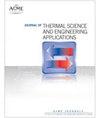Experimental study and simulation of thermal conductivity of saturated frozen soil
IF 1.4
4区 工程技术
Q3 ENGINEERING, MECHANICAL
引用次数: 1
Abstract
The aim of this study was to enhance the accuracy of predicting the temperature field of frozen soil and to reduce the workload of thermal parameter testing. To achieve this, we employed a three-phase model comprising soil, water, and ice. The unfrozen water content in frozen soil at varying temperatures was determined using nuclear magnetic resonance spectroscopy (NMR), while the thermal conductivity was measured by a thermal characteristic analyzer. A MATLAB software-based random model of the frozen soil was then established and imported into COMSOL simulation software. The repeatability and reproducibility of the established model were verified by varying the proportions of pore water and frozen ice to determine the degree of simulation accuracy.The results demonstrated that the unfrozen water content maintained a dynamic equilibrium relationship with temperature, which influenced the thermal conductivity of frozen soil. The simulation results were consistent with those obtained from instrument measurements of trends with respect to temperature. The average PBIAS value between the calculated and measured values was 0.0139, indicating theoretical feasibility. Comparison with experimental data confirmed the effectiveness of our approach, providing a novel concept and a simple method for predicting the temperature field of frozen soil engineering in areas that experience seasonal freezing.饱和冻土导热系数的实验研究与模拟
本研究旨在提高冻土温度场预测的准确性,减少热参数测试的工作量。为了实现这一点,我们采用了一个由土壤、水和冰组成的三相模型。采用核磁共振波谱法测定不同温度下冻土的未冻水含量,热特性分析仪测定冻土的热导率。建立了基于MATLAB软件的冻土随机模型,并导入COMSOL仿真软件。通过改变孔隙水和冻结冰的比例来验证所建立模型的重复性和再现性,以确定模拟精度的程度。结果表明:冻土区未冻水含量与温度保持动态平衡关系,影响冻土的导热系数。模拟结果与仪器对温度变化趋势的测量结果一致。计算值与实测值的平均PBIAS值为0.0139,表明理论可行性。与实验数据的对比验证了该方法的有效性,为季节性冻结地区冻土工程温度场的预测提供了一种新颖的概念和简单的方法。
本文章由计算机程序翻译,如有差异,请以英文原文为准。
求助全文
约1分钟内获得全文
求助全文
来源期刊

Journal of Thermal Science and Engineering Applications
THERMODYNAMICSENGINEERING, MECHANICAL -ENGINEERING, MECHANICAL
CiteScore
3.60
自引率
9.50%
发文量
120
期刊介绍:
Applications in: Aerospace systems; Gas turbines; Biotechnology; Defense systems; Electronic and photonic equipment; Energy systems; Manufacturing; Refrigeration and air conditioning; Homeland security systems; Micro- and nanoscale devices; Petrochemical processing; Medical systems; Energy efficiency; Sustainability; Solar systems; Combustion systems
 求助内容:
求助内容: 应助结果提醒方式:
应助结果提醒方式:


